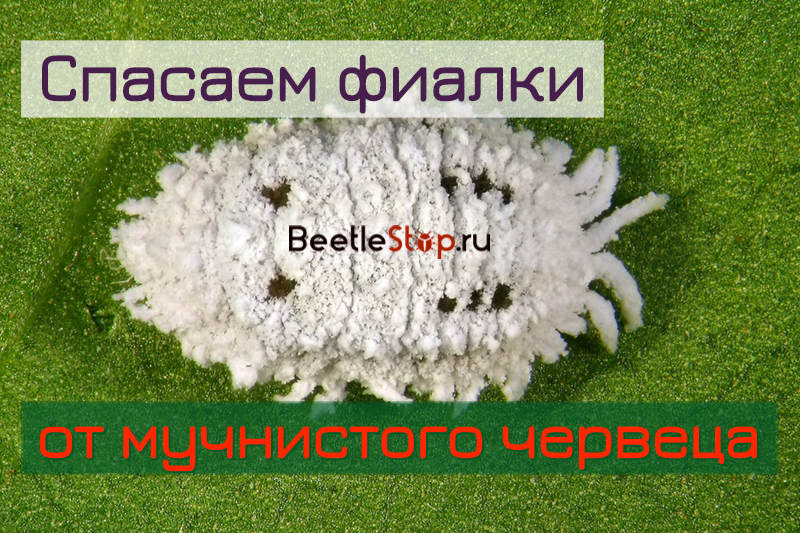Fighting a Mealybug on Violets: An Overview of Methods
Senpoly lovers know how many misfortunes a mealybug on violets can bring. In advanced cases, this pest brings the plant to death. The use of special tools will help prevent this.

Who is the mealybug?
Mealybug is a small insect (3–6 mm) with a rounded white body, covered with numerous flagella. For this, it received its "popular" name - "hairy louse." Mealybugs are best known as plant pests, including indoor violets. The insect has many species, but on the senpolia, the most common is the seaside and bristly mealybug.
Signs of violet infection
Mealybugs not only suck the juice from the leaves of violets, making the plant weak. They spend part of their life in the ground, and therefore harm the root system.
Signs that wound up on a violet mealybug:
- Foxes grow dull, acquire a pale yellow or gray tint. Old leaves soften, becoming like jelly, and young gradually fade.
- The growth of outlets stops.
- The buds either wither without blooming, or do not form at all.
- The root and socket rot.
- There are white lumps in the axils of the leaves.
- The trunk of the earth is covered with white bloom.
Usually they learn about infection when a mealybug has already managed to infect a large part of the plant.
Destruction of the mealybug on the senpolia
How to deal with mealybug on violets? First of all, after detecting a pest, it should:
- remove the affected leaves of senpolia;
- wash the plant with a cotton swab dipped in soapy water;
- isolate violet from other indoor flowers - quarantine will help prevent mass destruction.
After that, you can start using insecticidal or folk remedies.
Insecticides
The fastest and most rational way to drive a mealybug from violets is to treat the infected plants and their neighbors with insecticides. They are on sale in a wide range, have various mechanisms of action and are effective not only against worms, but also against other pests.
For the processing of indoor violets most often use:
- “Aktaru”;
- "Actellik";
- Bazudin
- Confidor
- Mospilan and others.
The use of chemicals that have a more delicate effect (for example, "Fitoverma") can be a waste of time and money. Mealybugs have an excellent protective mechanism, so the relatively "weak" insecticides are not able to destroy the pest.
For the same reason, experienced flower growers advise in the fight against mealybug on violets to make the solution 1.5–2 times more saturated in concentration than indicated in the instructions for the drug. Also, these creatures have the ability to get used to certain toxic substances, so it is better to change insecticides with each application for a different composition or to make the solution stronger.
For the best effect, the pot with violets after processing is wrapped in a plastic bag for 2 days.
In total, it is recommended to carry out at least 2 treatments, and preferably 3. The interval between them should be 7-10 days.If, after 2 months after the start of the treatments, the appearance of the violets does not improve, then drastic measures should be taken: transplant the senpolia into a new soil with root treatment with a contact pesticide or destroy the plant with the rooting of its healthy or processed leaves.
The mealybug also destroys the biological preparation “Lepodocide”.
Folk remedies
Folk remedies are significantly less effective than chemicals. But in two cases, their use is justified:
- if the infection has not become widespread;
- if the violet is not a valuable specimen and you can experiment with her health.
What methods of struggle with the worm for the senpolis to choose is the business of each grower. If he decides to use natural folk remedies, then this may be:
- Soap solution. For best results, you can add a teaspoon of ammonia to a glass of water and a tablespoon of planed soap. Household is best suited, but you can also use tar and other varieties. In an extreme case, use a dishwashing detergent.
- Infusion of garlic: 5 minced cloves insist in a glass of water for 24–48 hours.
- Onion infusion: 1 medium onion in a glass of water. Wait 3 hours.
- A decoction of red hot pepper. Finely chopped hot pepper, and 30 g of raw material is boiled for 1 hour over low heat. Then the liquid should be infused for 1 day.
- Tobacco (shag). 80 g insist in 1 liter of water for 1 day.
These folk remedies process all leaflets, flowers and stems with a cotton pad or folded gauze. It is necessary to spill the soil, wipe the pot with liquid and even the space around the violet. One procedure will not be enough: it will take several treatments with an interval of 1 week to completely get rid of the worm.
Prevention
Preventive measures that can 100% guarantee the safety of violets from a mealybug do not exist. Florists are advised to maintain optimal conditions for the plant and provide it with proper care, because a weakened flower is most vulnerable to pests and diseases.
Once every six months, you can do a preventive strait with a systemic insecticide, which will make violet deadly for the worm. It is strictly forbidden to use the soil remaining after the death of plants, repeatedly. The pot needs to be disinfected, for example, by baking it in the oven.
Mealybug inflicts great damage to violets: the appearance of outlets worsens, they cease to bloom. To bring your favorite plant back to life, you need to start the fight against the pest as soon as possible.


 (votes: 10, average rating: 4,30 out of 5)
(votes: 10, average rating: 4,30 out of 5)